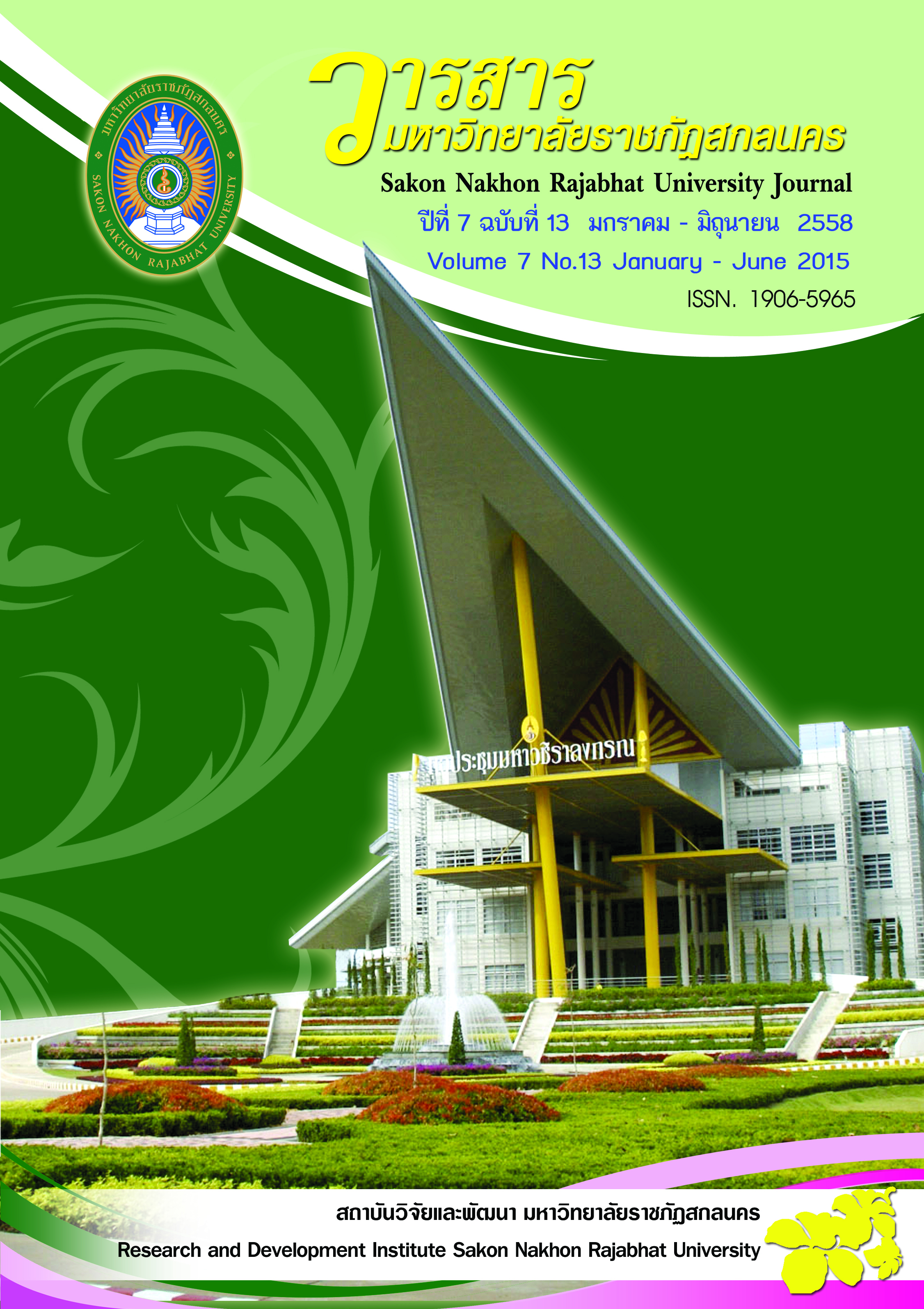การพัฒนาวิธีการจัดทำบัญชีแบบมีส่วนร่วมของกองทุนหมู่บ้าน ในเขตตำบลท่าแร่ จังหวัดสกลนคร
Abstract
บทคัดย่อ
การพัฒนาวิธีการจัดทำบัญชีแบบมีส่วนร่วมของกองทุนหมู่บ้านในเขตตำบลท่าแร่ จังหวัดสกลนคร มีวัตถุประสงค์เพื่อศึกษาสภาพปัญหาและอุปสรรคในการทำบัญชีของกองทุนหมู่บ้านตำบลท่าแร่ และพัฒนาความรู้ของเกษตรกรเกี่ยวกับวิธีการจัดทำบัญชีแบบมีส่วนร่วม การวิจัยใช้ระเบียบวิธีวิจัยแบบผสมผสานระหว่าง การวิจัยปฏิบัติการแบบมีส่วนร่วม และการวิจัยเชิงปริมาณ โดยใช้สถิติเชิงพรรณนา ได้แก่ ค่าร้อยละ กลุ่มเป้าหมาย คือ เกษตรกรที่เป็นประธาน กรรมการ สมาชิก และผู้จัดทำบัญชีของกองทุนหมู่บ้านฯ ซึ่งมีทั้งหมด 8 กองทุนๆ ละ 6 คน รวมเป็น 48 คน สุ่มตัวอย่างแบบเจาะจงกรณีประธานและกองทุนหมู่บ้านฯ กับสุ่มแบบโควต้ากรณีกรรมการและสมาชิกกองทุนฯ เครื่องมือที่ใช้ในการวิจัยมี 2 ชนิด ได้แก่ 1) แบบสัมภาษณ์แบบมีโครงสร้าง และ 2) แบบทดสอบทางบัญชี ที่ใช้อบรมกับเกษตรกรกลุ่มเป้าหมาย
ผลการศึกษาพบว่า ปัญหาและอุปสรรคในการจัดทำบัญชีของกองทุนหมู่บ้าน คือ 1) ไม่มีเอกสารหลักฐานที่ใช้ประกอบการบันทึกบัญชี หรือมีแต่ไม่ครบถ้วน อีกทั้งมีความยุ่งยากในการเตรียมแบบฟอร์มทางบัญชีและสมุดบัญชีที่ต้องใช้งาน 2) เกษตรกรไม่กล้าบันทึกบัญชีจริงในสมุดเพราะกลัวข้อมูลผิดพลาด จึงทำให้การบันทึกบัญชีซ้ำซ้อนหรือลืมบันทึกบัญชี 3) การบันทึกบัญชีตามความสะดวกและตามความเข้าใจ โดยใช้เกณฑ์เงินสดในการบันทึกบัญชี 4) การบันทึกบัญชีล่าช้า ไม่ทันสมัย ทำให้ไม่สามารถให้ข้อมูลที่ทันต่อเหตุการณ์และไม่สามารถตอบสนองความต้องการใช้ข้อมูลเพื่อประกอบการตัดสินใจในการบริหารจัดการกองทุนได้ 5) ไม่มีระบบการติดตามหรือตรวจสอบหนี้สงสัยจะสูญและหนี้สูญที่เกิดขึ้นจากลูกหนี้ที่กู้ยืมเงินกองทุนไป และ 6) เกษตรกรที่เคยไปอบรมกับหน่วยงานต่าง ๆ ในภาครัฐ เมื่อจะลงมือปฏิบัติจริงก็ไม่สามารถจัดทำบัญชีได้ ต้องขอความช่วยเหลือจากครูบัญชีอาสา
จากปัญหาและอุปสรรคข้างต้น ผู้วิจัยและเกษตรกรได้ร่วมกันอภิปรายและแสดงความคิดเห็น ส่งผลให้เกิดวิธีการจัดทำบัญชีแบบมีส่วนร่วม ซึ่งมีรายละเอียด ดังนี้
1. การแยกรายการค้าออกเป็น 2 กิจกรรม คือ กิจกรรมเกี่ยวกับเงินกองทุน 1 ล้านบาท และกิจกรรมเกี่ยวกับเงินออม หรือเงินรับฝากจากสมาชิก
2. แบ่งระบบบัญชีของกองทุนหมู่บ้าน เป็น 3 ส่วน ได้แก่ 1) เอกสารที่ใช้ในการบันทึกบัญชีและสมุดบัญชีที่เกี่ยวข้อง 2) วิธีการบันทึกบัญชี แบ่งเป็น 3 ระบบ ได้แก่ ระบบบัญชีเกี่ยวกับการรับเงิน /จ่ายเงิน / การรับสินทรัพย์เป็นการชำระค่าหุ้นหรือการรับบริจาค และ 3) การจัดทำรายงานทางการเงิน
คำสำคัญ : การพัฒนา, วิธีการจัดทำบัญชี, การวิจัยเชิงปฏิบัติการแบบมีส่วนร่วม
Abstract
This research on the development of participatory book-keeping of village funds in Tharae Sub-district, Sakon Nakhon Province aimed to study and identify problems and obstacles in participatory book-keeping of funds in villages of Tharae Sub-district and to improve farmers’ knowledge on participatory book-keeping. This study employed a mixed research method between participatory action research and a quantitative research by using descriptive statistics in percentage. The target group consisted of chairs of the funds, members of the committees, ordinary members and bookkeepers in 8 groups of funds, totally 48 participants. Purposive sampling was used in the case of chairs of the funds and the funds along with quota sampling in the case of members of the committees and ordinary members. Research tools used included 1) a structured interview and 2) an accounting test on book-keeping used with the target farmers. Data were analyzed and reported in percentage.
The findings of this study were as follows:
The problems and obstacles in doing book-keeping of the village funds comprised:
1. There were no documents as evidences for book-keeping, or there were some but inadequate. In addition, there were some difficulties in preparing book-keeping forms and an account book.
2. The farmers dared not to write down the actual information due to the fear of making mistake. This led to the double book-keeping or else the forgetting of doing book-keeping.
3. Account books were recorded according to convenience and understanding of Cash Basis; in other words, the records were done only by cash payment.
4. Records were delayed and out–of-date; therefore the information was not up-to-date and did not help make a decision to manage the funds.
5. There was no follow-up process or inspection on bad debts and doubtful accounts from debtors.
6. The bookkeepers were unable to operate book-keeping by themselves after training sessions with government organizations or from a handbook of fund book-keeping. Eventually, they required help from social development staffers or voluntary accounting teachers.
According to the above problems and obstacles, the researcher together with the farmers discussed and expressed and exchanging their opinions. As a result, there was an advent of the participatory book-keeping with the following details:
1. The accounting transaction was divided into 2 activities, which were an activity related to the 1 million-baht fund and an activity related to savings or deposit from the members.
2. The bookkeeping system of the village funds was divided into 3 parts, which were 1) documents used for book-keeping and related account books, 2) accounting, divided into 3 systems: accounting system on deposit/withdrawal, obtaining assets/properties as share payment or donation, and 3) financial report.
Keywords : Development, Book-keeping, Participatory Action Research









